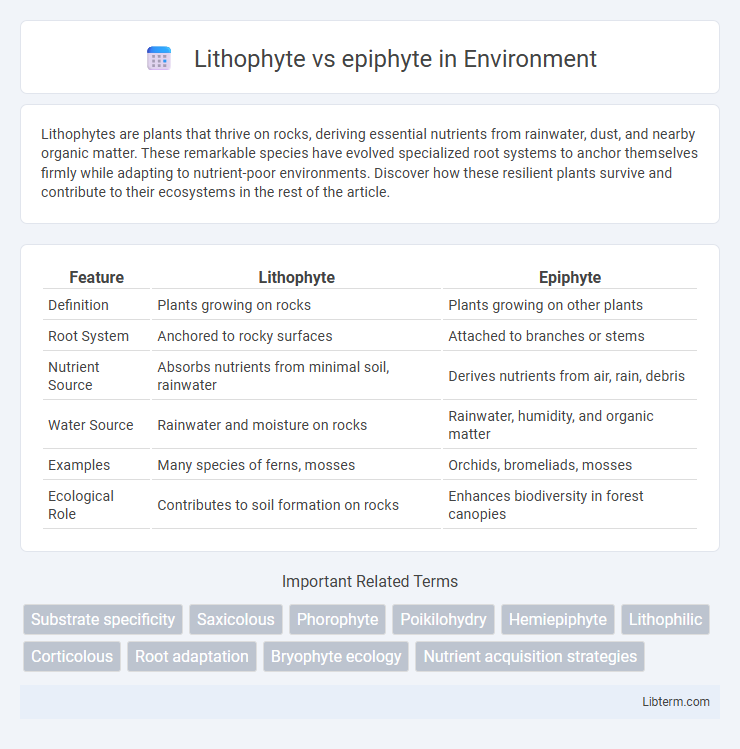Lithophytes are plants that thrive on rocks, deriving essential nutrients from rainwater, dust, and nearby organic matter. These remarkable species have evolved specialized root systems to anchor themselves firmly while adapting to nutrient-poor environments. Discover how these resilient plants survive and contribute to their ecosystems in the rest of the article.
Table of Comparison
| Feature | Lithophyte | Epiphyte |
|---|---|---|
| Definition | Plants growing on rocks | Plants growing on other plants |
| Root System | Anchored to rocky surfaces | Attached to branches or stems |
| Nutrient Source | Absorbs nutrients from minimal soil, rainwater | Derives nutrients from air, rain, debris |
| Water Source | Rainwater and moisture on rocks | Rainwater, humidity, and organic matter |
| Examples | Many species of ferns, mosses | Orchids, bromeliads, mosses |
| Ecological Role | Contributes to soil formation on rocks | Enhances biodiversity in forest canopies |
Introduction to Lithophytes and Epiphytes
Lithophytes grow on rocks, deriving nutrients from rainwater, mineral deposits, and organic matter, adapting to harsh, nutrient-poor environments. Epiphytes live on other plants, especially trees, without parasitizing them, absorbing moisture and nutrients from the air and debris. Both plant types exhibit specialized adaptations for survival in unique habitats, playing vital roles in ecosystem dynamics and biodiversity.
Definition of Lithophytes
Lithophytes are plants that grow directly on rocks, extracting nutrients and moisture from the mineral surface and surrounding environment without soil. Unlike epiphytes, which grow on other plants, lithophytes adapt to harsh, nutrient-poor conditions by developing specialized root systems to anchor onto rocky substrates. These plants play a crucial ecological role in colonizing bare rocks, contributing to soil formation over time.
Definition of Epiphytes
Epiphytes are plants that grow non-parasitically on other plants, deriving moisture and nutrients from the air, rain, and debris accumulating around them. In contrast, lithophytes grow on rocks, obtaining nutrients from rainwater, moss, and decomposing matter. Both adaptations enable plants to thrive in challenging environments by exploiting different substrates without harming their hosts.
Key Differences Between Lithophytes and Epiphytes
Lithophytes grow on rocks, obtaining nutrients from rainwater and surrounding debris, while epiphytes live on other plants, especially trees, using them solely for physical support without extracting nutrients from their hosts. Lithophytes are adapted to minimal soil environments with specialized root systems for anchorage, whereas epiphytes possess aerial roots that absorb moisture and nutrients from the air. The distinct habitats of lithophytes and epiphytes reflect their unique ecological roles and adaptations in diverse ecosystems.
Habitat and Environmental Adaptations
Lithophytes thrive on rocky substrates, extracting nutrients from minimal soil and moisture trapped in crevices, showcasing adaptations like extensive root systems for anchorage and water absorption. Epiphytes grow on other plants, primarily trees, adapting to obtain moisture and nutrients from the air, rain, and debris, with specialized structures such as velamen roots and water storage tissues. Both plant types exhibit remarkable adaptations for survival in nutrient-poor environments, maximizing their access to limited water and light resources.
Morphological Features of Lithophytes
Lithophytes exhibit specialized root systems adapted for anchoring onto rocky substrates, often developing flattened or tufted roots to maximize surface adherence and nutrient absorption from minimal soil or moss layers. Their leaves tend to be thick, succulent, or leathery to reduce water loss in exposed, nutrient-poor environments. Unlike epiphytes, which grow on other plants, lithophytes possess morphological traits tailored to survive harsh, rocky habitats with limited organic matter.
Morphological Features of Epiphytes
Epiphytes exhibit specialized morphological features such as thickened stems and leaves for water storage, trichomes for moisture absorption, and aerial roots adapted for anchorage and nutrient absorption from the air. These adaptations enable epiphytes to thrive on host plants without soil contact, differentiating them from lithophytes that root directly on rocks. The presence of velamen in the roots enhances water uptake in epiphytic orchids, exemplifying their unique morphology for survival in nutrient-poor environments.
Nutrient Acquisition Strategies
Lithophytes acquire nutrients primarily from rainwater, decomposed organic matter, and minerals found in rocky substrates, often adapting root systems to absorb scarce resources efficiently. Epiphytes obtain nutrients from atmospheric deposition, organic debris, and moisture collected on host plants, relying heavily on specialized structures like trichomes or velamen roots to maximize nutrient uptake without soil contact. Both plant types exhibit unique physiological adaptations that minimize competition for soil nutrients and optimize survival in nutrient-poor environments.
Examples of Lithophytic and Epiphytic Plants
Lithophytes include species such as saxifrage and certain orchids adapted to grow on rocky surfaces, utilizing minimal soil and extracting nutrients from rainwater and debris. Epiphytes, like bromeliads, ferns, and many orchids, thrive on tree branches, absorbing moisture and nutrients directly from the air without harming their host plants. These distinct growth habits demonstrate specialized adaptations to survive in nutrient-poor environments, with lithophytes anchored to rocks and epiphytes reliant on aerial roots.
Ecological Roles and Benefits
Lithophytes grow on rocks and contribute to soil formation by breaking down mineral substrates through biological weathering, providing habitats for microorganisms and small invertebrates. Epiphytes live on other plants without harming them, enhancing biodiversity by creating microhabitats and improving air quality through efficient nutrient cycling and moisture retention. Both plant types play crucial roles in stabilizing ecosystems, supporting nutrient exchange, and promoting habitat complexity in their respective environments.
Lithophyte Infographic

 libterm.com
libterm.com